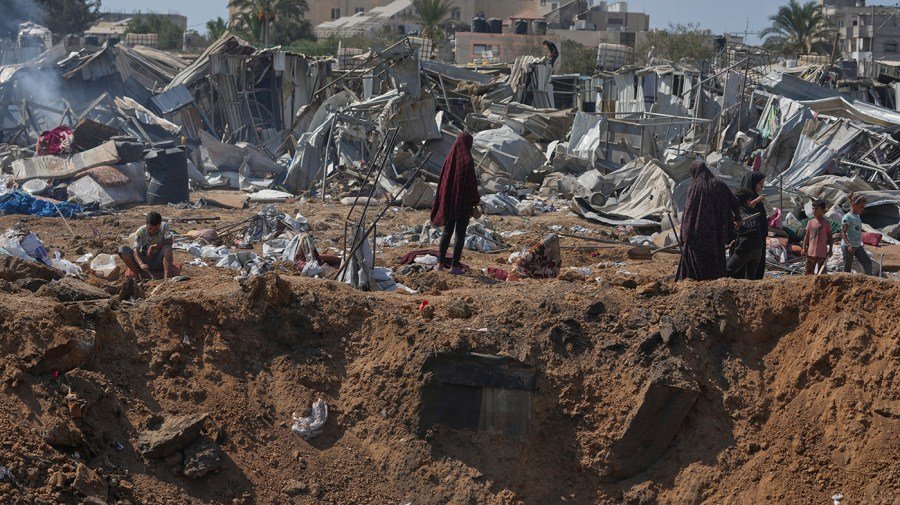
A growing number of experts, including two respected Israeli NGOs and a genocide scholar, have recently determined that Israel is committing genocide in Gaza. Israeli Prime Minister Benjamin Netanyahu has challenged these allegations, asserting that if Israel wanted to commit genocide, “We could have done the Dresden bombing on them, but we don’t because that’s not the way we conduct war.”
Netanyahu’s invocation of the February 1945 firebombing of Dresden is presumably meant to create a stark contrast to an episode that represents a nonpareil example of excessive wartime devastation. But the dreadful reality is that Israel effectively has “done the Dresden bombing” in the course of its military campaign in Gaza.
Damage mapping shows that Israel has in fact destroyed the built environment in Gaza at a rate comparable to the destruction in Dresden, particularly in northern Gaza. Independently of whether Israel is committing genocide, this destruction of Gaza has violated international law, going well beyond the permissible parameters for using force in self-defense.
During the first year of Israel’s war against Hamas in Gaza, Israeli forces damaged or destroyed nearly 60 percent of all buildings in all of Gaza and 70 percent of all housing stock. In the two northern governorates, damage rates were particularly severe: 70 percent and 74 percent of all buildings were damaged or destroyed, and 80 percent of all housing stock. This is comparable to the level of damage in Dresden, where 80 percent of residential buildings, 56 percent of non-industrial buildings, and 23 percent of industrial buildings were damaged or destroyed.
By July 2025, 78 percent of all buildings across all of Gaza have been damaged or destroyed, comparable to damage rates in Dresden. Overall damage rates in Gaza also surpass the damage in Nagasaki (40 percent) and Hiroshima (67 percent) after the atomic bomb detonations in 1945.
Beyond World War II, the damage inflicted in Gaza dwarfs damage rates in other modern, highly destructive urban wars like those in Ukraine or Syria. Damage to infrastructure necessary for civilian survival has been similarly severe, with 94 percent of all health facilities and 84 percent of all water, sanitation and hygiene facilities across Gaza damaged or destroyed in the first 10 months of the war alone.
Nor can this level of damage be justified as a valid exercise of Israel’s right of self-defense, as some of Israel’s supporters have argued. While Israel undoubtedly has the right to use force to defend itself following Hamas’s brutal October 7 attacks, this does not grant Israel the right to use any amount of force it deems necessary to eliminate any possible future threat it believes Hamas poses, no matter how tenuous or far in the future.
Nor may Israel disregard the consequences for Gaza or its civilian population. Instead, Israel is bound by international law under the centuries-old principle of “jus ad bellum proportionality,” which dictates that Israel may not cause damage and harm in Gaza that is excessive in view of reducing tangible threats of future attacks from Hamas. The damage Israel has wrought onto Gaza is excessive in view of reducing tangible threats of future attacks from Hamas, going even beyond rates of damage in other destructive modern conflicts.
Indeed, we argue in a forthcoming publication that Israel’s decision to pursue a full-scale ground invasion with the strategic objective of eliminating Hamas’s military capabilities and removing it from political power violated international law from the beginning.
Israeli officials knew they could not have achieved this far-reaching objective without significant destruction of Gaza, given contextual information that was well-known to them at the time: Gaza is densely populated and has limited areas for civilians to flee or seek safety, that Hamas has integrated its military capabilities within the Gazan civilian population — to be sure, in some cases in violation of international law — and that Hamas has built an extensive network of tunnels.
International law is not a suicide pact, and Israel had other options available to reduce tangible threats of future Hamas attacks and restore its security, as senior U.S. military experts then advised Israeli officials. But it chose not to pursue those options, and inflicted on Gaza and the Palestinian people a level of damage comparable to Dresden and worse than the atomic bomb detonations.
The era in which this level of devastation is seen as an acceptable way of waging war is over. Israel must be meaningfully pressured by allied states to end the war. Allied states providing security support to Israel should immediately halt forms of security cooperation that are assisting the use of excessive force in Gaza, as some have already done.
This may force Israel to face a difficult reality: that it cannot achieve its strategic objective of eliminating Hamas’s military capabilities and removing it from political power without violating international law. But Israel’s inability to accept this to date has produced intolerable devastation for Gaza and the Palestinians who live there. It’s well past time to end current hostilities.
Bailey Ulbricht is the founding executive director of the Stanford Humanitarian Program, a research program at Stanford Law School aimed at reducing harm in conflict settings. Allen S. Weiner is senior lecturer in law at Stanford Law School. He served as a career international lawyer in the State Department from 1990 to 2001 and as legal counselor at the U.S. Embassy in the Hague.

